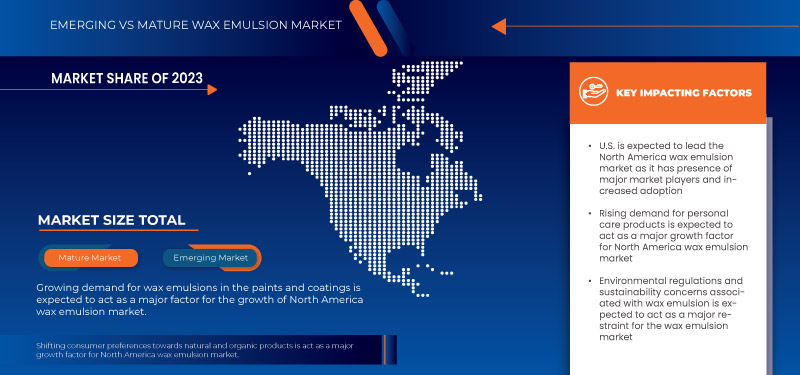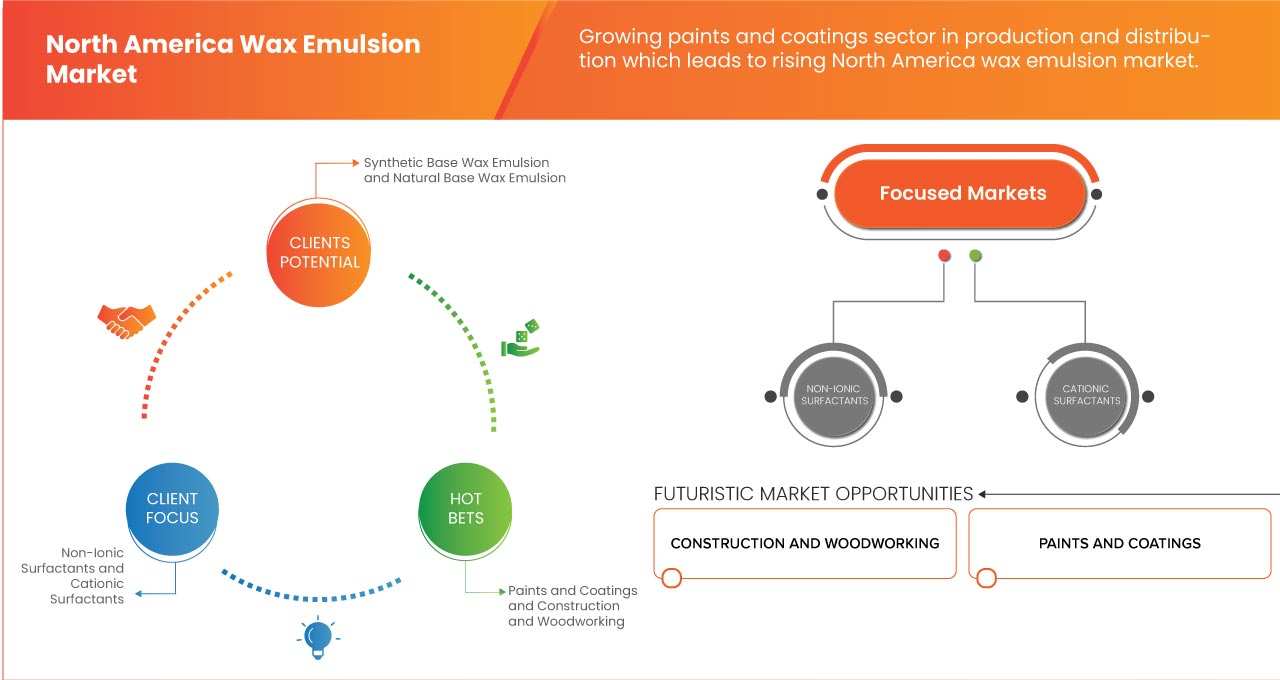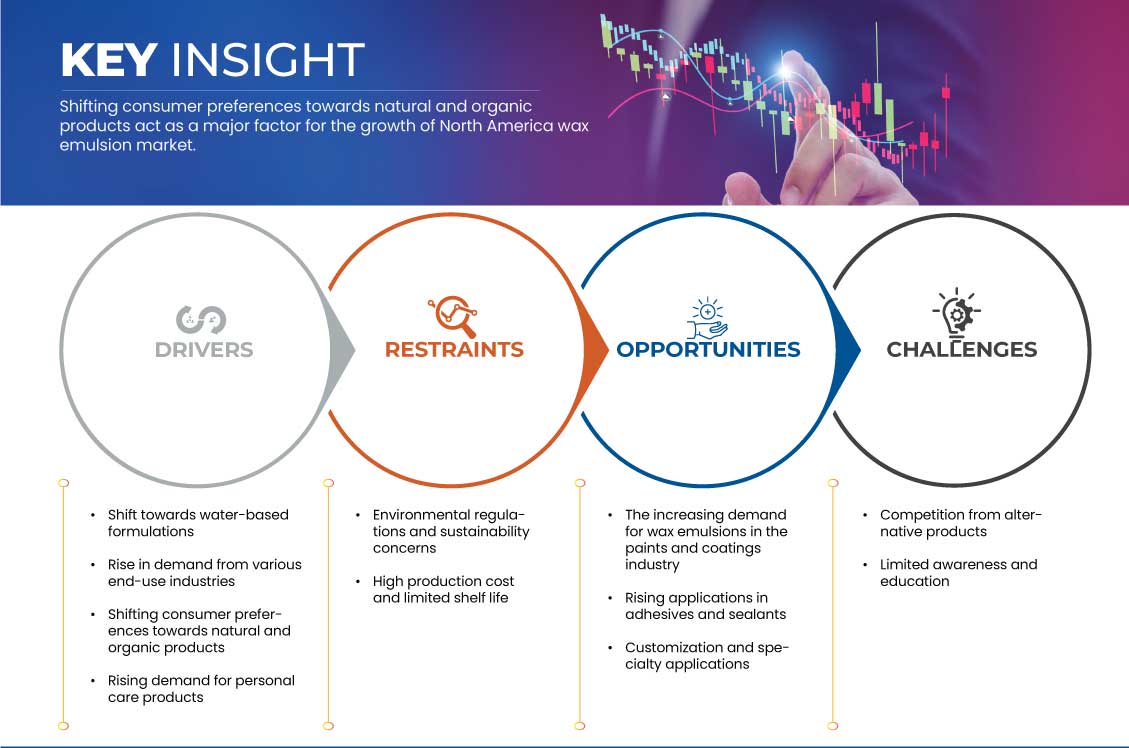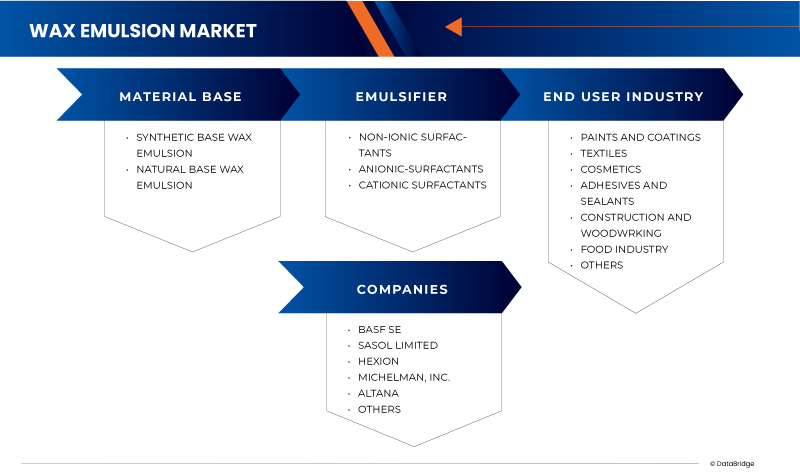North America Wax Emulsion Market
حجم السوق بالمليار دولار أمريكي
CAGR :
% 
| 2024 –2031 | |
| USD 696.63 Million | |
| USD 845.26 Million | |
|
|
|
>سوق مستحلب الشمع في أمريكا الشمالية، حسب قاعدة المادة (مستحلب الشمع ذو القاعدة الاصطناعية ومستحلب الشمع ذو القاعدة الطبيعية)، المستحلب (المواد الخافضة للتوتر السطحي غير الأيونية، والمواد الخافضة للتوتر السطحي الأنيونية، والمواد الخافضة للتوتر السطحي الكاتيونية)، صناعة المستخدم النهائي (الدهانات والطلاءات، والمنسوجات، ومستحضرات التجميل، والمواد اللاصقة والمواد المانعة للتسرب، والبناء والنجارة، وصناعة الأغذية، وغيرها) - اتجاهات الصناعة والتوقعات حتى عام 2031.
تحليل وحجم سوق مستحلب الشمع في أمريكا الشمالية
الطلب المتزايد في الصناعات ذات الاستخدام النهائي مثل الدهانات والطلاءات والمواد اللاصقة والمنسوجات والتعبئة والتغليف هو المحرك لنمو السوق. الاستخدام الصناعي لمستحلب الشمع الحيوي محدود بسبب اللوائح البيئية ومخاوف الاستدامة، مما قد يقيد نمو السوق. ومن المتوقع أن تشكل المنافسة من المنتجات البديلة والوعي والتعليم المحدود تحديًا لنمو السوق.
تحلل شركة Data Bridge Market Research أن سوق مستحلب الشمع في أمريكا الشمالية من المتوقع أن ينمو بمعدل نمو سنوي مركب بنسبة 2.5٪ من عام 2024 إلى عام 2031 ومن المتوقع أن يصل إلى 845.26 مليون دولار أمريكي بحلول عام 2031 من 696.63 مليون دولار أمريكي في عام 2023.
|
تقرير القياس |
تفاصيل |
|
فترة التنبؤ |
2024 إلى 2031 |
|
سنة الأساس |
2023 |
|
سنوات تاريخية |
2022 (قابلة للتخصيص حتى 2016-2021) |
|
وحدات كمية |
الإيرادات بالملايين من الدولارات الأمريكية |
|
القطاعات المغطاة |
المواد الأساسية (مستحلب الشمع الأساسي الصناعي ومستحلب الشمع الأساسي الطبيعي)، المستحلب (المواد الخافضة للتوتر السطحي غير الأيونية والمواد الخافضة للتوتر السطحي الأنيونية والمواد الخافضة للتوتر السطحي الكاتيونية )، صناعة المستخدم النهائي (الدهانات والطلاءات، والمنسوجات، ومستحضرات التجميل ، والمواد اللاصقة والمواد المانعة للتسرب، والبناء والنجارة، وصناعة الأغذية، وغيرها) |
|
الدول المغطاة |
الولايات المتحدة وكندا والمكسيك |
|
الجهات الفاعلة في السوق المشمولة |
Hexion، وBASF SE، وMichelman، Inc.، وSasol Limited، وALTANA، وRepsol، وThe Lubrizol Corporation، وPMC Group، Inc.، وWacker Chemie AG، وHenry Company، وH&R GROUP، وMicro Powders، Inc.، وSHAMROCK، وCHT Germany GmbH، وParaffwaxco، Inc.، وNanjing Tianshi New Material Technologies Co.، Ltd وغيرها |
تعريف السوق
المستحلب الشمعي هو خليط مستقر يتألف من جزيئات شمعية صغيرة موزعة بالتساوي في الماء بمساعدة المستحلبات. تمنح هذه التركيبة مستحلبات الشمع خصائص مفيدة مختلفة، مما يجعلها إضافات متعددة الاستخدامات عبر صناعات متعددة. في الطلاء والدهانات، تعمل كمضافات فعالة، وتوفر فوائد مثل مقاومة الخدش المحسنة، وطرد الماء، وتأثيرات التكتل. يستخدم قطاع الورق والتعبئة والتغليف مستحلبات الشمع لتعزيز لمعان السطح وقابلية الطباعة ومقاومة الرطوبة للمنتجات الورقية. بالإضافة إلى ذلك، في البناء، يتم استخدامها كطارد للماء، وعوامل معالجة، وإضافات في تركيبات الملاط والخرسانة، مما يحسن المتانة والأداء. تستخدم الصناعات النسيجية مستحلبات الشمع لإضفاء النعومة وطرد الماء على الأقمشة. علاوة على ذلك، تعد مستحلبات الشمع جزءًا لا يتجزأ من مستحضرات التجميل، مما يسهل صياغة الكريمات والمستحضرات ومنتجات العناية الشخصية الأخرى. مع تطبيقاتها المتنوعة وفوائدها الوظيفية، تلعب مستحلبات الشمع دورًا حاسمًا في تحسين خصائص وأداء المواد المختلفة عبر الصناعات.
ديناميكيات سوق مستحلب الشمع في أمريكا الشمالية
يتناول هذا القسم فهم محركات السوق والفرص والقيود والتحديات. وسيتم مناقشة كل هذا بالتفصيل أدناه.
السائقين
- ارتفاع الطلب من مختلف الصناعات ذات الاستخدام النهائي
تتمتع مستحلبات الشمع بالعديد من الفوائد التي تلبي الاحتياجات المتغيرة للصناعات النهائية. على سبيل المثال، في قطاع الدهانات والطلاءات، تُستخدم مستحلبات الشمع لتحسين خصائص أداء الطلاء مثل مقاومة الخدش واللمعان والالتصاق والمتانة. وبالمثل، تُستخدم مستحلبات الشمع في تطبيقات التشطيب النسيجي لإضافة صفات مثل النعومة ومقاومة الماء ومقاومة التجاعيد. إن قدرتها على تلبية متطلبات الصناعة الفريدة تجعلها مكونات أساسية في أنواع مختلفة من عمليات الإنتاج.
- التحول نحو المستحضرات المعتمدة على الماء
إن التركيبات القائمة على الماء تنبعث منها مركبات عضوية متطايرة أقل من نظيراتها القائمة على المذيبات، مما يجعلها أكثر ملاءمة للبيئة. ومع تشديد القواعد لمكافحة تلوث الهواء والحد من انبعاثات المركبات العضوية المتطايرة، تتحول قطاعات مثل الدهانات والطلاءات والمواد اللاصقة والمنسوجات إلى التركيبات القائمة على الماء. ويعزز هذا الضغط التنظيمي استخدام مستحلبات الشمع القائمة على الماء. وتشكل المخاوف البيئية المحرك الرئيسي لهذا الاتجاه.
توفر التركيبات القائمة على الماء العديد من فوائد الأداء. فهي غالبًا ما تكون ذات رائحة أقل، وسلامة أعلى في التعامل، وتوافق أفضل مع المواد المضافة الأخرى مقارنة بالتركيبات القائمة على المذيبات. وتضيف هذه الخصائص إلى قيمة مستحلبات الشمع القائمة على الماء في مجموعة متنوعة من التطبيقات، مما يعزز قبولها في مختلف الصناعات.
فرصة
- الطلب المتزايد على مستحلبات الشمع في صناعة الدهانات والطلاءات
The paints and coatings industry is experiencing a significant transformation due to the growing demand for environmentally friendly and sustainable products. This shift is driven by increasing awareness of environmental issues, stringent regulations on volatile organic compounds (VOCs), and a general preference for eco-friendly solutions. There is a rising demand for coatings that have minimal environmental impact, reducing the emission of harmful substances into the atmosphere. Consumers, regulatory bodies, and industries are increasingly favoring products that align with sustainability goals. Wax emulsions offer a compelling solution as additives in paint and coating formulations to meet these eco-friendly requirements. Being water-based, they contribute to lower volatile organic compounds (VOC) content in coatings compared to traditional solvent-based formulations. This aligns with the industry's goal to reduce environmental harm and improve indoor air quality.
Restraint/Challenge
- Environmental Regulations and Sustainability Concerns
Governments around the world have implemented stringent environmental restrictions in order to decrease pollution, carbon emissions, and preserve natural resources. Compliance with these requirements frequently necessitates that producers invest in costly equipment upgrades, deploy pollution control measures, and adhere to stringent emission limits. Furthermore, regulatory constraints can necessitate product reformulation to fulfill stringent environmental standards, such as lowering volatile organic compound (VOC) emissions or replacing dangerous chemicals with safer substitutes. These regulatory restrictions raise operating costs and regulatory compliance complexity, limiting market expansion for wax emulsion manufacturers.
Concerns about sustainability generate demand for environmentally friendly products and manufacturing techniques in a variety of industries. Consumers, corporations, and regulatory agencies are increasingly valuing sustainability and looking for products that have a low environmental effect throughout their entire lifecycle, from raw material procurement to disposal. In response, wax emulsion makers are under pressure to embrace sustainable practices such as using renewable raw materials, lowering energy use, reducing waste output, and introducing eco-friendly packaging solutions. However, shifting to sustainable practices require considerable upfront investments, operational obstacles, and supply chain complications, creating barriers to market entry and expansion.
Recent Developments
- In December 2023, according to PetroNaft Co., wax emulsions add texture and stability to creams, lotions, and hair care products, enhancing their moisturizing properties. In cosmetics like lipsticks and eyeshadows, they contribute to the smooth application and longevity of the product
- In November 2022, according to an article published by Elsevier B.V., over the past few years, emulsions with a small droplet size (fine dispersed emulsions, homogeneous emulsions, or submicron emulsions) have become of particular practical importance, especially in cosmetics and pharmacy (healing ointments and creams)
North America Wax Emulsion Market Scope
North America wax emulsion market is segmented into three notable segments based on material base, emulsifier, and end user industry. The growth amongst these segments will help you analyze major growth segments in the industries and provide the users with a valuable market overview and market insights to make strategic decisions to identify core market applications.
Material Base
- Synthetic Base Wax Emulsion
- Natural Base Wax Emulsion
On the basis of material base, the North America wax emulsion market is segmented into synthetic base wax emulsion and natural base wax emulsion.
Emulsifier
- Non-Ionic Surfactants
- Anionic-Surfactants
- Cationic Surfactants
On the basis of emulsifier, the North America wax emulsion market is segmented into non-ionic surfactants, anionic-surfactants, and cationic surfactants.
End User Industry
- Paints and Coatings
- Textiles
- Cosmetics
- Adhesives and Sealants
- Construction and Woodworking
- Food Industry
- Others
On the basis of end user industry, the North America wax emulsion market is segmented into paints and coatings, textiles, cosmetics, adhesives and sealants, construction and woodworking, food industry, and others.
North America Wax Emulsion Market Region Analysis/Insights
North America wax emulsion market is segmented into three notable segments based on material base, emulsifier, and end user industry.
The countries covered in the North America wax emulsion market are U.S., Canada, and Mexico.
U.S. is expected to dominate the market due to increasing demand from end user industries and advancement in technologies. The increased construction and infrastructure activities and increasing demand from packaging industry are also propelling the market growth in the country.
The country section of the report also provides individual market-impacting factors and changes in market regulation that impact the current and future trends of the market. Data point downstream and upstream value chain analysis, technical trends porter's five forces analysis, and case studies are some of the pointers used to forecast the market scenario for individual countries. Also, the presence and availability of North America brands and their challenges faced due to large or scarce competition from local and domestic brands, the impact of domestic tariffs, and trade routes are considered while providing forecast analysis of the country data.
Competitive Landscape and North America Wax Emulsion Market Share Analysis
يوفر المشهد التنافسي لسوق مستحلب الشمع في أمريكا الشمالية تفاصيل حسب المنافسين. تتضمن التفاصيل نظرة عامة على الشركة، والبيانات المالية للشركة، والإيرادات المتولدة، وإمكانات السوق، والاستثمار في البحث والتطوير، ومبادرات السوق الجديدة، ومواقع الإنتاج والمرافق، ونقاط القوة والضعف في الشركة، وإطلاق المنتج، وخطوط أنابيب تجارب المنتج، وموافقات المنتج، وبراءات الاختراع، وعرض المنتج ونطاقه، وهيمنة التطبيق، ومنحنى شريان الحياة التكنولوجي. ترتبط نقاط البيانات المذكورة أعلاه فقط بتركيز الشركات فيما يتعلق بسوق مستحلب الشمع في أمريكا الشمالية.
بعض المشاركين البارزين الذين يعملون في سوق مستحلب الشمع في أمريكا الشمالية هم Hexion و BASF SE و Michelman، Inc. و Sasol Limited و ALTANA و Repsol و The Lubrizol Corporation و PMC Group، Inc. و Wacker Chemie AG و Henry Company و H&R GROUP و Micro Powders، Inc. و SHAMROCK و CHT Germany GmbH و Paraffinwaxco، Inc. و Nanjing Tianshi New Material Technologies Co.، Ltd وغيرها.
SKU-
احصل على إمكانية الوصول عبر الإنترنت إلى التقرير الخاص بأول سحابة استخبارات سوقية في العالم
- لوحة معلومات تحليل البيانات التفاعلية
- لوحة معلومات تحليل الشركة للفرص ذات إمكانات النمو العالية
- إمكانية وصول محلل الأبحاث للتخصيص والاستعلامات
- تحليل المنافسين باستخدام لوحة معلومات تفاعلية
- آخر الأخبار والتحديثات وتحليل الاتجاهات
- استغل قوة تحليل المعايير لتتبع المنافسين بشكل شامل
Table of Content
1 INTRODUCTION
1.1 OBJECTIVES OF THE STUDY
1.2 MARKET DEFINITION
1.3 OVERVIEW
1.4 LIMITATIONS
1.5 MARKETS COVERED
2 MARKET SEGMENTATION
2.1 MARKETS COVERED
2.2 GEOGRAPHICAL SCOPE
2.3 YEARS CONSIDERED FOR THE STUDY
2.4 CURRENCY AND PRICING
2.5 DBMR TRIPOD DATA VALIDATION MODEL
2.6 MULTIVARIATE MODELING
2.7 PRIMARY INTERVIEWS WITH KEY OPINION LEADERS
2.8 DBMR MARKET POSITION GRID
2.9 MARKET END USER COVERAGE GRID
2.1 DBMR VENDOR SHARE ANALYSIS
2.11 SECONDARY SOURCES
2.12 ASSUMPTIONS
3 EXECUTIVE SUMMARY
4 PREMIUM INSIGHTS
4.1 PORTER'S FIVE FORCES
4.1.1 THE THREAT OF NEW ENTRANTS
4.1.2 THE THREAT OF SUBSTITUTES
4.1.3 CUSTOMER BARGAINING POWER
4.1.4 SUPPLIER BARGAINING POWER
4.1.5 INTERNAL COMPETITION (RIVALRY)
4.2 PRICE TREND ANALYSIS
4.3 CLIMATE CHANGE SCENARIO
4.4 SUPPLY CHAIN ANALYSIS
4.4.1 RAW MATERIAL PROCUREMENT
4.4.2 MANUFACTURING AND PACKING
4.4.3 MARKETING AND DISTRIBUTION
4.4.4 END USERS
4.5 TECHNOLOGICAL ADVANCEMENTS BY MANUFACTURERS
5 NORTH AMERICA WAX EMULSION MARKET: REGULATION COVERAGE
6 MARKET OVERVIEW
6.1 DRIVERS
6.1.1 SHIFTING CONSUMER PREFERENCES TOWARDS NATURAL AND ORGANIC PRODUCTS
6.1.2 RISE IN DEMAND FROM VARIOUS END-USE INDUSTRIES
6.1.3 SHIFT TOWARDS WATER-BASED FORMULATIONS
6.1.4 RISING DEMAND FOR PERSONAL CARE PRODUCTS
6.2 RESTRAINTS
6.2.1 ENVIRONMENTAL REGULATIONS AND SUSTAINABILITY CONCERNS
6.2.2 HIGH PRODUCTION COSTS AND LIMITED SHELF LIFE
6.3 OPPORTUNITIES
6.3.1 THE INCREASING DEMAND FOR WAX EMULSIONS IN THE PAINTS AND COATINGS INDUSTRY
6.3.2 RISING APPLICATIONS IN ADHESIVES AND SEALANTS
6.3.3 CUSTOMIZATION AND SPECIALTY APPLICATIONS
6.4 CHALLENGES
6.4.1 COMPETITION FROM ALTERNATIVE PRODUCTS
6.4.2 LIMITED AWARENESS AND EDUCATION
7 NORTH AMERICA WAX EMULSION MARKET, BY MATERIAL BASE
7.1 OVERVIEW
7.2 SYNTHETIC BASE WAX EMULSION
7.2.1 SYNTHETIC BASE WAX EMULSION, BY TYPE
7.3 NATURAL BASE WAX EMULSION
7.3.1 NATURAL BASE WAX EMULSION, BY TYPE
8 NORTH AMERICA WAX EMULSION MARKET, BY EMULSIFIER
8.1 OVERVIEW
8.2 NON-IONIC SURFACTANTS
8.3 ANIONIC-SURFACTANTS
8.4 CATIONIC SURFACTANTS
9 NORTH AMERICA WAX EMULSION MARKET, BY END USER INDUSTRY
9.1 OVERVIEW
9.2 PAINTS AND COATINGS
9.2.1 PAINTS AND COATINGS, BY MATERIAL BASE
9.3 TEXTILES
9.3.1 TEXTILES, BY MATERIAL BASE
9.4 COSMETICS
9.4.1 COSMETICS, BY MATERIAL BASE
9.5 ADHESIVES AND SEALANTS
9.5.1 ADHESIVES AND SEALANTS, BY MATERIAL BASE
9.6 CONSTRUCTION AND WOODWORKING
9.6.1 CONSTRUCTION AND WOODWORKING, BY MATERIAL BASE
9.7 FOOD INDUSTRY
9.7.1 FOOD INDUSTRY, BY MATERIAL BASE
9.8 OTHERS
9.8.1 OTHERS, BY MATERIAL BASE
10 NORTH AMERICA WAX EMULSION MARKET, BY COUNTRY
10.1 NORTH AMERICA
10.1.1 U.S.
10.1.2 CANADA
10.1.3 MEXICO
11 NORTH AMERICA WAX EMULSION MARKET, COMPANY LANDSCAPE
11.1 COMPANY SHARE ANALYSIS: NORTH AMERICA
11.2 NEW FORMULATION
12 SWOT ANALYSIS
13 COMPANY PROFILES
13.1 HEXION
13.1.1 COMPANY SNAPSHOT
13.1.2 PRODUCT PORTFOLIO
13.1.3 RECENT DEVELOPMENTS
13.2 BASF SE
13.2.1 COMPANY SNAPSHOT
13.2.2 REVENUE ANALYSIS
13.2.3 PRODUCT PORTFOLIO
13.2.4 RECENT DEVELOPMENTS
13.3 MICHELMAN, INC.
13.3.1 COMPANY SNAPSHOT
13.3.2 PRODUCT PORTFOLIO
13.3.3 RECENT DEVELOPMENTS
13.4 SASOL LIMITED
13.4.1 COMPANY SNAPSHOT
13.4.2 REVENUE ANALYSIS
13.4.3 PRODUCT PORTFOLIO
13.4.4 RECENT DEVELOPMENTS
13.5 ALTANA
13.5.1 COMPANY SNAPSHOT
13.5.2 PRODUCT PORTFOLIO
13.6 CHT GERMANY GMBH
13.6.1 COMPANY SNAPSHOT
13.6.2 PRODUCT PORTFOLIO
13.6.3 RECENT DEVELOPMENT
13.7 HENRY COMPANY
13.7.1 COMPANY SNAPSHOT
13.7.2 PRODUCT PORTFOLIO
13.7.3 RECENT DEVELOPMENTS
13.8 H&R GROUP
13.8.1 COMPANY SNAPSHOT
13.8.2 REVENUE ANALYSIS
13.8.3 PRODUCT PORTFOLIO
13.8.4 RECENT DEVELOPMENT
13.9 MICRO POWDERS, INC.
13.9.1 COMPANY SNAPSHOT
13.9.2 PRODUCT PORTFOLIO
13.9.3 RECENT DEVELOPMENT
13.1 NANJING TIANSHI NEW MATERIAL TECHNOLOGIES CO., LTD
13.10.1 COMPANY SNAPSHOT
13.10.2 PRODUCT PORTFOLIO
13.10.3 RECENT DEVELOPMENT
13.11 PARAFFINWAXCO, INC.
13.11.1 COMPANY SNAPSHOT
13.11.2 PRODUCT PORTFOLIO
13.11.3 RECENT DEVELOPMENT
13.12 PMC GROUP, INC.
13.12.1 COMPANY SNAPSHOT
13.12.2 PRODUCT PORTFOLIO
13.12.3 RECENT DEVELOPMENT
13.13 REPSOL
13.13.1 COMPANY SNAPSHOT
13.13.2 REVENUE ANALYSIS
13.13.3 PRODUCT PORTFOLIO
13.13.4 RECENT DEVELOPMENTS
13.14 SHAMROCK
13.14.1 COMPANY SNAPSHOT
13.14.2 PRODUCT PORTFOLIO
13.14.3 RECENT DEVELOPMENT
13.15 THE LUBRIZOL CORPORATION
13.15.1 COMPANY SNAPSHOT
13.15.2 PRODUCT PORTFOLIO
13.15.3 RECENT DEVELOPMENT
13.16 WACKER CHEMIE AG
13.16.1 COMPANY SNAPSHOT
13.16.2 REVENUE ANALYSIS
13.16.3 PRODUCT PORTFOLIO
13.16.4 RECENT DEVELOPMENT
14 QUESTIONNAIRE
15 RELATED REPORTS
List of Table
TABLE 1 REGULATORY FRAMEWORK
TABLE 2 NORTH AMERICA WAX EMULSION MARKET, BY MATERIAL BASE, 2022-2031 (USD THOUSAND)
TABLE 3 NORTH AMERICA WAX EMULSION MARKET, BY MATERIAL BASE, 2022-2031 (TONS)
TABLE 4 NORTH AMERICA SYNTHETIC BASE WAX EMULSION IN WAX EMULSION MARKET, BY TYPE, 2022-2031 (USD THOUSAND)
TABLE 5 NORTH AMERICA NATURAL BASE WAX EMULSION IN WAX EMULSION MARKET, BY TYPE, 2022-2031 (USD THOUSAND)
TABLE 6 NORTH AMERICA WAX EMULSION MARKET, BY EMULSIFIER, 2022-2031 (USD THOUSAND)
TABLE 7 NORTH AMERICA WAX EMULSION MARKET, BY END USER INDUSTRY, 2022-2031 (USD THOUSAND)
TABLE 8 NORTH AMERICA PAINTS AND COATINGS IN WAX EMULSION MARKET, BY MATERIAL BASE, 2022-2031 (USD THOUSAND)
TABLE 9 NORTH AMERICA TEXTILES IN WAX EMULSION MARKET, BY MATERIAL BASE, 2022-2031 (USD THOUSAND)
TABLE 10 NORTH AMERICA COSMETICS IN WAX EMULSION MARKET, BY MATERIAL BASE, 2022-2031 (USD THOUSAND)
TABLE 11 NORTH AMERICA ADHESIVES AND SEALANTS IN WAX EMULSION MARKET, BY MATERIAL BASE, 2022-2031 (USD THOUSAND)
TABLE 12 NORTH AMERICA CONSTRUCTION AND WOODWORKING IN WAX EMULSION MARKET, BY MATERIAL BASE, 2022-2031 (USD THOUSAND)
TABLE 13 NORTH AMERICA FOOD INDUSTRY IN WAX EMULSION MARKET, BY MATERIAL BASE, 2022-2031 (USD THOUSAND)
TABLE 14 NORTH AMERICA OTHERS IN WAX EMULSION MARKET, BY MATERIAL BASE, 2022-2031 (USD THOUSAND)
TABLE 15 NORTH AMERICA WAX EMULSION MARKET, BY COUNTRY, 2022-2031 (USD THOUSAND)
TABLE 16 U.S. WAX EMULSION MARKET, BY MATERIAL BASE, 2022-2031 (USD THOUSAND)
TABLE 17 U.S. WAX EMULSION MARKET, BY MATERIAL BASE, 2022-2031 (TONS)
TABLE 18 U.S. SYNTHETIC BASE WAX EMULSION IN WAX EMULSION MARKET, BY TYPE, 2022-2031 (USD THOUSAND)
TABLE 19 U.S. NATURAL BASE WAX EMULSION IN WAX EMULSION MARKET, BY TYPE, 2022-2031 (USD THOUSAND)
TABLE 20 U.S. WAX EMULSION MARKET, BY EMULSIFIER, 2022-2031 (USD THOUSAND)
TABLE 21 U.S. WAX EMULSION MARKET, BY END USER INDUSTRY, 2022-2031 (USD THOUSAND)
TABLE 22 U.S. PAINTS AND COATINGS IN WAX EMULSION MARKET, BY MATERIAL BASE, 2022-2031 (USD THOUSAND)
TABLE 23 U.S. TEXTILES IN WAX EMULSION MARKET, BY MATERIAL BASE, 2022-2031 (USD THOUSAND)
TABLE 24 U.S. COSMETIC IN WAX EMULSION MARKET, BY MATERIAL BASE, 2022-2031 (USD THOUSAND)
TABLE 25 U.S. ADHESIVES AND SEALANTS IN WAX EMULSION MARKET, BY MATERIAL BASE, 2022-2031 (USD THOUSAND)
TABLE 26 U.S. CONSTRUCTION AND WOODWORKING IN WAX EMULSION MARKET, BY MATERIAL BASE, 2022-2031 (USD THOUSAND)
TABLE 27 U.S. FOOD INDUSTRY IN WAX EMULSION MARKET, BY MATERIAL BASE, 2022-2031 (USD THOUSAND)
TABLE 28 U.S. OTHERS IN WAX EMULSION MARKET, BY MATERIAL BASE, 2022-2031 (USD THOUSAND)
TABLE 29 CANADA WAX EMULSION MARKET, BY MATERIAL BASE, 2022-2031 (USD THOUSAND)
TABLE 30 CANADA WAX EMULSION MARKET, BY MATERIAL BASE, 2022-2031 (TONS)
TABLE 31 CANADA SYNTHETIC BASE WAX EMULSION IN WAX EMULSION MARKET, BY TYPE, 2022-2031 (USD THOUSAND)
TABLE 32 CANADA NATURAL BASE WAX EMULSION IN WAX EMULSION MARKET, BY TYPE, 2022-2031 (USD THOUSAND)
TABLE 33 CANADA WAX EMULSION MARKET, BY EMULSIFIER, 2022-2031 (USD THOUSAND)
TABLE 34 CANADA WAX EMULSION MARKET, BY END USER INDUSTRY, 2022-2031 (USD THOUSAND)
TABLE 35 CANADA PAINTS AND COATINGS IN WAX EMULSION MARKET, BY MATERIAL BASE, 2022-2031 (USD THOUSAND)
TABLE 36 CANADA TEXTILES IN WAX EMULSION MARKET, BY MATERIAL BASE, 2022-2031 (USD THOUSAND)
TABLE 37 CANADA COSMETIC IN WAX EMULSION MARKET, BY MATERIAL BASE, 2022-2031 (USD THOUSAND)
TABLE 38 CANADA ADHESIVES AND SEALANTS IN WAX EMULSION MARKET, BY MATERIAL BASE, 2022-2031 (USD THOUSAND)
TABLE 39 CANADA CONSTRUCTION AND WOODWORKING IN WAX EMULSION MARKET, BY MATERIAL BASE, 2022-2031 (USD THOUSAND)
TABLE 40 CANADA FOOD INDUSTRY IN WAX EMULSION MARKET, BY MATERIAL BASE, 2022-2031 (USD THOUSAND)
TABLE 41 CANADA OTHERS IN WAX EMULSION MARKET, BY MATERIAL BASE, 2022-2031 (USD THOUSAND)
TABLE 42 MEXICO WAX EMULSION MARKET, BY MATERIAL BASE, 2022-2031 (USD THOUSAND)
TABLE 43 MEXICO WAX EMULSION MARKET, BY MATERIAL BASE, 2022-2031 (TONS)
TABLE 44 MEXICO SYNTHETIC BASE WAX EMULSION IN WAX EMULSION MARKET, BY TYPE, 2022-2031 (USD THOUSAND)
TABLE 45 MEXICO NATURAL BASE WAX EMULSION IN WAX EMULSION MARKET, BY TYPE, 2022-2031 (USD THOUSAND)
TABLE 46 MEXICO WAX EMULSION MARKET, BY EMULSIFIER, 2022-2031 (USD THOUSAND)
TABLE 47 MEXICO WAX EMULSION MARKET, BY END USER INDUSTRY, 2022-2031 (USD THOUSAND)
TABLE 48 MEXICO PAINTS AND COATINGS IN WAX EMULSION MARKET, BY MATERIAL BASE, 2022-2031 (USD THOUSAND)
TABLE 49 MEXICO TEXTILES IN WAX EMULSION MARKET, BY MATERIAL BASE, 2022-2031 (USD THOUSAND)
TABLE 50 MEXICO COSMETIC IN WAX EMULSION MARKET, BY MATERIAL BASE, 2022-2031 (USD THOUSAND)
TABLE 51 MEXICO ADHESIVES AND SEALANTS IN WAX EMULSION MARKET, BY MATERIAL BASE, 2022-2031 (USD THOUSAND)
TABLE 52 MEXICO CONSTRUCTION AND WOODWORKING IN WAX EMULSION MARKET, BY MATERIAL BASE, 2022-2031 (USD THOUSAND)
TABLE 53 MEXICO FOOD INDUSTRY IN WAX EMULSION MARKET, BY MATERIAL BASE, 2022-2031 (USD THOUSAND)
TABLE 54 MEXICO OTHERS IN WAX EMULSION MARKET, BY MATERIAL BASE, 2022-2031 (USD THOUSAND)
List of Figure
FIGURE 1 NORTH AMERICA WAX EMULSION MARKET
FIGURE 2 NORTH AMERICA WAX EMULSION MARKET: DATA TRIANGULATION
FIGURE 3 NORTH AMERICA WAX EMULSION MARKET: DROC ANALYSIS
FIGURE 4 NORTH AMERICA WAX EMULSION MARKET: COUNTRY VS REGIONAL MARKET ANALYSIS
FIGURE 5 NORTH AMERICA WAX EMULSION MARKET: COMPANY RESEARCH ANALYSIS
FIGURE 6 NORTH AMERICA WAX EMULSION MARKET: MULTIVARIATE MODELLING
FIGURE 7 NORTH AMERICA WAX EMULSION MARKET: INTERVIEW DEMOGRAPHICS
FIGURE 8 NORTH AMERICA WAX EMULSION MARKET: DBMR MARKET POSITION GRID
FIGURE 9 NORTH AMERICA WAX EMULSION MARKET: MARKET END USER COVERAGE GRID
FIGURE 10 NORTH AMERICA WAX EMULSION MARKET: VENDOR SHARE ANALYSIS
FIGURE 11 NORTH AMERICA WAX EMULSION MARKET: SEGMENTATION
FIGURE 12 RISING DEMAND FOR PERSONAL CARE PRODUCTS IS EXPECTED TO DRIVE THE NORTH AMERICA WAX EMULSION MARKET IN THE FORECAST PERIOD
FIGURE 13 THE SYNTHETIC BASE WAX EMULSION IS EXPECTED TO ACCOUNT FOR THE LARGEST SHARE OF THE NORTH AMERICA WAX EMULSION MARKET IN 2024 AND 2031
FIGURE 14 PORTER’S FIVE FORCES
FIGURE 15 PRICE TREND ANALYSIS FOR NORTH AMERICA WAX EMULSION MARKET (USD/KG)
FIGURE 16 DRIVERS, RESTRAINTS, OPPORTUNITIES, AND CHALLENGES OF NORTH AMERICA WAX EMULSION MARKET
FIGURE 17 NORTH AMERICA WAX EMULSION MARKET: BY MATERIAL BASE, 2023
FIGURE 18 NORTH AMERICA WAX EMULSION MARKET: BY EMULSIFIER, 2023
FIGURE 19 NORTH AMERICA WAX EMULSION MARKET: BY END USER INDUSTRY, 2023
FIGURE 20 NORTH AMERICA WAX EMULSION MARKET: SNAPSHOT (2023)
FIGURE 21 NORTH AMERICA WAX EMULSION MARKET: COMPANY SHARE 2023 (%)

منهجية البحث
يتم جمع البيانات وتحليل سنة الأساس باستخدام وحدات جمع البيانات ذات أحجام العينات الكبيرة. تتضمن المرحلة الحصول على معلومات السوق أو البيانات ذات الصلة من خلال مصادر واستراتيجيات مختلفة. تتضمن فحص وتخطيط جميع البيانات المكتسبة من الماضي مسبقًا. كما تتضمن فحص التناقضات في المعلومات التي شوهدت عبر مصادر المعلومات المختلفة. يتم تحليل بيانات السوق وتقديرها باستخدام نماذج إحصائية ومتماسكة للسوق. كما أن تحليل حصة السوق وتحليل الاتجاهات الرئيسية هي عوامل النجاح الرئيسية في تقرير السوق. لمعرفة المزيد، يرجى طلب مكالمة محلل أو إرسال استفسارك.
منهجية البحث الرئيسية التي يستخدمها فريق بحث DBMR هي التثليث البيانات والتي تتضمن استخراج البيانات وتحليل تأثير متغيرات البيانات على السوق والتحقق الأولي (من قبل خبراء الصناعة). تتضمن نماذج البيانات شبكة تحديد موقف البائعين، وتحليل خط زمني للسوق، ونظرة عامة على السوق ودليل، وشبكة تحديد موقف الشركة، وتحليل براءات الاختراع، وتحليل التسعير، وتحليل حصة الشركة في السوق، ومعايير القياس، وتحليل حصة البائعين على المستوى العالمي مقابل الإقليمي. لمعرفة المزيد عن منهجية البحث، أرسل استفسارًا للتحدث إلى خبراء الصناعة لدينا.
التخصيص متاح
تعد Data Bridge Market Research رائدة في مجال البحوث التكوينية المتقدمة. ونحن نفخر بخدمة عملائنا الحاليين والجدد بالبيانات والتحليلات التي تتطابق مع هدفهم. ويمكن تخصيص التقرير ليشمل تحليل اتجاه الأسعار للعلامات التجارية المستهدفة وفهم السوق في بلدان إضافية (اطلب قائمة البلدان)، وبيانات نتائج التجارب السريرية، ومراجعة الأدبيات، وتحليل السوق المجدد وقاعدة المنتج. ويمكن تحليل تحليل السوق للمنافسين المستهدفين من التحليل القائم على التكنولوجيا إلى استراتيجيات محفظة السوق. ويمكننا إضافة عدد كبير من المنافسين الذين تحتاج إلى بيانات عنهم بالتنسيق وأسلوب البيانات الذي تبحث عنه. ويمكن لفريق المحللين لدينا أيضًا تزويدك بالبيانات في ملفات Excel الخام أو جداول البيانات المحورية (كتاب الحقائق) أو مساعدتك في إنشاء عروض تقديمية من مجموعات البيانات المتوفرة في التقرير.









